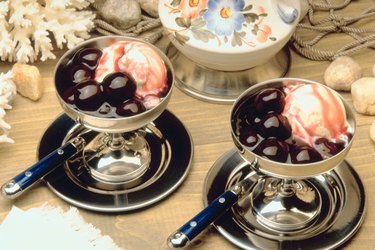
Starches are some of the most useful thickeners for cooks. They provide a relatively quick and reliable way to produce thick sauces and fillings. Custards are much more problematic, relying on the gentler thickening power of egg proteins to create a delicate gel. Creme anglaise, a basic vanilla-flavored custard sauce, is the most basic example of the technique. It refrigerates readily for later use, but freezing it can be another matter.
How Custards Work
Video of the Day
If you've ever watched eggs in a skillet, you have a basic understanding of how heat affects their proteins. As they become warmer, the proteins set into the familiar firm texture that's the signature of a properly fried egg. If you dilute your scrambled eggs with cream, it prevents the proteins from bonding as tightly and makes the eggs softer. Custards take that a step further, diluting the eggs with enough cream that they can only form the softest and most delicate of gels. Custards only hold their form within a narrow range of temperatures, quickly separating if they're frozen or overheated.
Video of the Day
Creme Anglaise
Creme anglaise is the most basic of custards. It's made by whisking eggs together with sugar, then gradually stirring in hot cream to dilute the mixture. The combination is heated gently, usually over a double boiler, until the egg proteins "set" the custard to a thick texture similar to heavy cream. You may add vanilla extract and sometimes butter at the end of the cooking time, or infuse the cream with a vanilla bean while it's heating. Pour the sauce over hot or cold desserts, and keep it refrigerated for three to four days.
Freezing and Thawing
Like any liquid, creme anglaise freezes easily. The difficulty comes with thawing the custard. Almost invariably, it will separate into a mixture of thin, milky liquid and thicker clumps of egg. If you don't have the ingredients to make a fresh batch, you can sometimes salvage your sauce with an extra egg yolk. Use a mixer or "stick" blender to recombine the sauce, then whisk an egg yolk in a separate mixing bowl. Add a few tablespoons of the thawed custard to your yolk and combine, then place the bowl over a double boiler. Whisk in the remaining custard and heat the mixture gently until it rethickens. The new egg yolk will return the other ingredients to a texture almost as fine as the original sauce.
Ice Cream
The best reason to freeze leftover creme anglaise is to produce ice cream. Pour any leftovers into the bowl of your ice cream maker and let it churn until the custard freezes. If you don't have an ice cream maker, let the custard freeze in an airtight container, then beat it vigorously for a few minutes with the paddle of your stand mixer. Return the mixture to your freezer to solidify once more. The plain frozen mixture can be eaten without whipping, but its texture is denser.
Variations
Tweak a basic creme anglaise mixture to make other sweet treats. Vary the number of whole eggs and egg yolks to produce relatively firm baked custards, such as the beloved Latin "flan," or softer custards such as creme brulee. Incorporate cornstarch or flour into the mixture to create a more stable custard called pastry cream. Pastry cream is often used as a filling, and the filled pastries can be frozen for later baking.